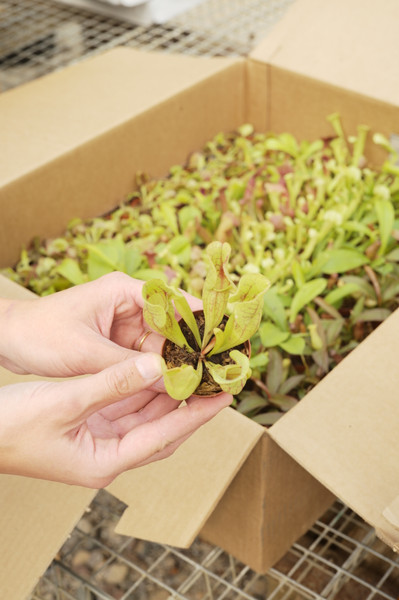Carnivorous Plant Chat
Posted by Hannah Brand on Oct 6th 2024
Weekly Plant Chat: Carnivorous Plants
Hey Plant Friends!
This week we are going to be talking about Carnivorous Plants. There are more than 600 species of carnivorous plants, making it one of the most diverse groups in the plant kingdom. Carnivorous plants can be found on every continent except Antarctica. There are even 14 species native to Minnesota, including the Purple Pitcher Plant. Carnivorous plants live in humid, wet conditions, and need to stay wet to survive.
A few species available at Tonkadale include Venus Flytrap (Dionaea), North American Pitcher Plant (Sarracenia), Tropical Pitcher Plant (Nepenthes), Butterwort (Pinguicula), and Sundew (Drosera).
Read more about Carnivorous plants and their amazing adaptations here!
Family of Origin
Evolutionary studies show that carnivorous plants evolved at least seven times in separate and in independent plant families: Droseraceae, Drosophyllaceae, Biblidaceae, Nepenthaceae, Cephalotaceae, Sarraceniaceae, and Lentibulariaceae.
Carnivorous plants can be grouped according to the type of trapping mechanism they use. Traps include pitfalls, flypaper, snap, bladder, and lobster-pot types.
Plant Care
Light
Carnivorous plants thrive in full sun. Bright, indirect light is best. Place in a south or west-facing window for best results.
Soil
Most all-purpose potting soils contain too many minerals for carnivorous plants. High minerality in soil water will cause roots to burn. Plant carnivorous plants in a 1:1mixture of organic peat moss and perlite if you’d like to mix your own.
Water
Always keep carnivorous plants evenly moist. Only water with distilled, deionized, demineralized, or rain water as the minerality of tap water can easily burn carnivorous plant roots.
Carnivorous plants love high humidity. 50 - 90% humidity is ideal. Add extra humidity by frequently misting, grouping plants together, or placing in a vessel such as a terrarium or tank.
Fertilizer
Do not fertilize carnivorous plants. The nutrients they require are absorbed when insects are digested. If plants are not receiving insects they can survive, but you may hand feed mealworms to supplement their diet. Carnivorous plants also catch fungus gnats, which is super helpful to keep pests at bay!
Hot Tips
Some carnivorous plants go dormant in colder months. Sarracenia varieties need this dormancy to survive. Others can skip dormancy and be just fine.
If you would like to force your plant into a dormancy period: make sure your plant is well-watered, wrap it in plastic, and place in a cool, dark room (refrigerator, basement, or garage). 50F degrees or lower is ideal. Make sure your plant doesn’t freeze, and check periodically for hydration.
Carnivorous plants produce flowers on a very long stem allowing pollinators to visit without the risk of being trapped.
Carnivorous plants are generally not toxic to our furry friends.
Shop Now!
Carnivorous plants are available in a wide range of varieties and sizes in the greenhouse.
Always approachable and happy to help!

